Answer these simple questions and we will find you the BEST prices
Which type of solar quotes do you need?
It only takes 30 seconds
100% free with no obligation

Get Free quotes from insulation specialists near you

Save money by comparing quotes and choosing the most competitive offer

The service is 100% free and with no obligation
- GreenMatch
- Insulation
- Roof Insulation
Roof Insulation: A Complete Guide (2025)

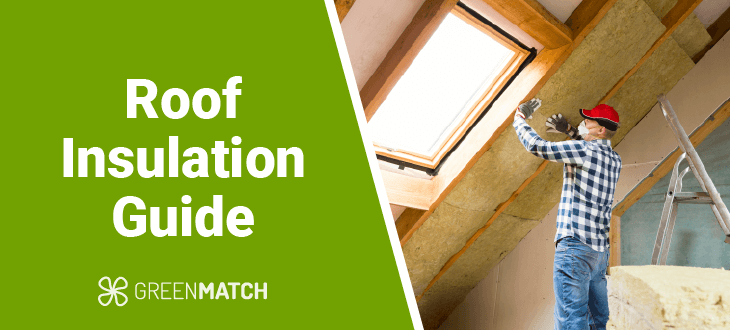
- Insufficient roof insulation can cause up to 26% heat loss, leading to higher energy bills and draughty living spaces.
- Insulating your roof can increase your home's value by 14% and make it more attractive to potential buyers.
- You can reduce your carbon footprint by 0.6 tonnes annually by updating or installing new roof insulation.
- Depending on your property type, you can save between £270 and £445 on your annual energy bills.
Poorly insulated roofs can result in up to 26% heat loss, leading to higher energy bills, reduced home value, and draughty living spaces. According to a study by the EDF, less than one-tenth of UK homes have insulation from 2002 or later, leaving almost 21 million homes with outdated and poorly insulated roofs.
Roof insulation is critical to home construction and energy efficiency. It keeps homes warmer in winter, cooler in summer, reduces energy costs, lowers carbon footprint, and increases property value.
This comprehensive guide will cover everything you need to know about insulation. This includes understanding the different types of insulation available, their benefits, available grants, and how to insulate a roof by yourself.
Whether you want to reduce your energy bills, enhance your home's comfort, or contribute to a greener planet, this guide offers valuable insights and practical tips to help you make informed decisions about insulating your roof.
Ready to upgrade your home's insulation? Look no further than GreenMatch. Get up to four free, personalised quotes from local experts to suit your needs and budget. Fill out our quick 30-second form in the link below to access these quotes as soon as possible.
- Describe your needs
- Get free quotes
- Choose the best offer
It only takes 30 seconds



Benefits of roof insulation
Roof insulation offers numerous benefits that significantly enhance the energy efficiency, comfort, and overall value of a home. Below are the benefits you can expect when upgrading or installing new insulation for your roof:
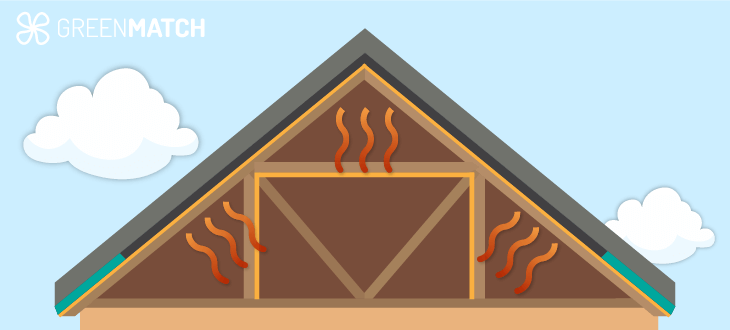
Prevents heat loss: Almost one-quarter of heat is lost during the winter months due to poorly insulated roofs. Insulation creates a barrier that slows down the movement of heat within your home and prevents it from escaping, especially in spaces like a room in the roof. It functions by trapping tiny pockets of air, which reduces the rate at which heat can escape from your roof.

Reduces heat gain: According to Community Action Energy, during the summer months, nearly 35% of cold air can be lost from uninsulated homes. Escaping cold air lets hot air enter, complicating temperature regulation in your home.
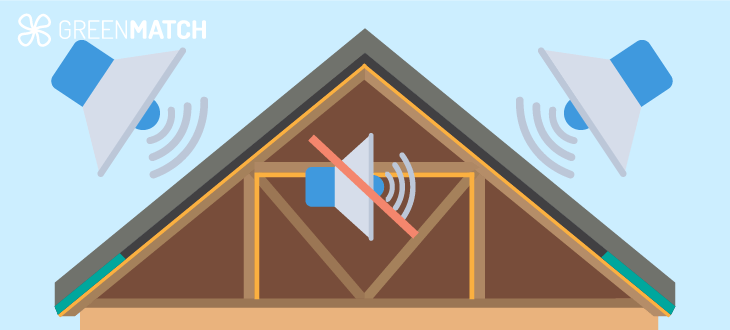
Noise reduction: Insulation is an extra barrier in your home, helping to absorb waves and create a quieter indoor environment. Thermal acoustic insulation slows down heat transfer and blocks sound transmission, reducing noise pollution. While standard insulation does reduce some noise, it's minimal. If you're looking for insulation that can effectively block and absorb sound waves, thermal acoustic insulation is the best option.

Increase property value: Roof insulation increases property value by improving energy efficiency, reducing utility costs, and enhancing comfort for potential buyers. According to GOV.UK, improving your EPC (Energy Performance Certificate) rating could raise your home's value by up to 14%.
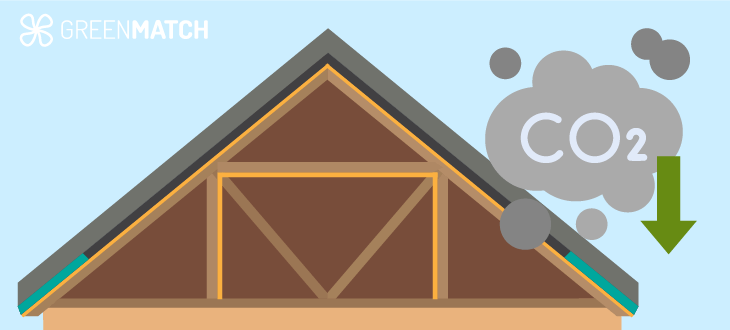
Reduces carbon footprint: Insulation for a roof reduces your carbon footprint by lowering the need for heating and cooling, thereby reducing the consumption of fossil fuels and energy resources. On average, you can save up to 0.6 tonnes of carbon emissions every year. Fewer greenhouse gas emissions make your home eco-friendly, contributing to global climate change efforts.
| Home type (England, Scotland, Wales) | Energy bill savings per year |
|---|---|
| Detached (00mm-270mm loft insulation) | £340 |
| Semi-detached (00mm-270mm loft insulation) | £200 |
| Mid-terrace (00mm-270mm loft insulation) | £180 |
| Detached bungalow (00mm-270mm loft insulation) | £300 |
| Detached (120mm - 270mm loft insulation) | £30 |
| Semi-detached (120mm - 270mm loft insulation) | £19 |
| Mid-terrace (120mm - 270mm loft insulation) | £17 |
| Detached bungalow (120mm - 270mm loft insulation) | £30 |
| Home type (Northern Ireland) | Energy bill savings per year |
|---|---|
| Detached (00mm-270mm loft insulation) | £475 |
| Semi-detached (00mm-270mm loft insulation) | £285 |
| Mid-terrace (00mm-270mm loft insulation) | £255 |
| Detached bungalow (00mm-270mm loft insulation) | £465 |
| Detached (120mm - 270mm loft insulation) | £45 |
| Semi-detached (120mm - 270mm loft insulation) | £25 |
| Mid-terrace (120mm - 270mm loft insulation) | £25 |
| Detached bungalow (120mm - 270mm loft insulation) | £45 |
Energy saving: Installing insulation in your roof can lead to significant savings on energy bills. On average, you can save up to £270 annually. However, these savings can vary based on your location and the type of property you have.
Roof space insulation can reduce heat loss during winter and keep homes cooler in summer, reducing the need for excessive heating and cooling. This improved energy efficiency results in lower energy consumption and substantial yearly savings on utility bills for homeowners.
Roof insulation cost in the UK

Roof insulation costs in the UK typically range from £740 to £1,700, depending on several factors. Pitched roofs generally cost more to insulate than flat roofs; prices vary by insulation material and property size. Additionally, roofs with complex features or limited access may require more labour, further increasing the overall cost.
The material you choose impacts the insulation price, so it's essential to know its average cost. Below, we have listed the costs of insulation materials per square metre (m2).
| Material | Average cost per m2 |
|---|---|
| Fibreglass | £10 |
| Polystyrene (EPS) Board | £10 |
| Cellulose | £11 |
| Polyisocyanurate(PIR) board | £12.50 |
| Mineral wool (glass) | £15.25 |
| Mineral wool (rock) | £18.20 |
| Sheeps wool | £19.75 |
| Polyurethane board | £21.50 |
| Spray foam open cell | £55 |
| Spray foam closed cell | £70 |
It's essential to consider which materials are best for your home. By consulting with an expert with in-depth knowledge of insulation materials and their respective R-values to your home, you can get the best value for your money and save on energy costs.
The cost of roof insulation can be influenced by the labour required for installation. This cost depends on the size of your roof and the difficulty involved in the installation process, which can cause the price to vary. Labour costs around £250 per person daily. Below are the average costs of labour for roof insulation:
| Type of insulation | Average cost per 20m2 (215.278 ft2) |
|---|---|
| Fibreglass (pitched roof) | £400 |
| Mineral wool rolls (pitched roof) | £440 |
| Warm deck (flat roof) | £650 |
| Spray foam (pitched roof) | £800 |
For precise roof insulation costs, consult with local experts to select the ideal material for your home and budget. Fill out GreenMatch's quick 30-second form to receive four free, no-obligation quotes from top roof insulation installers. Why waste time searching for installers when you can get them through us promptly? Click below to learn more.
- Describe your needs
- Get free quotes
- Choose the best offer
It only takes 30 seconds



Pitched or flat roof insulation
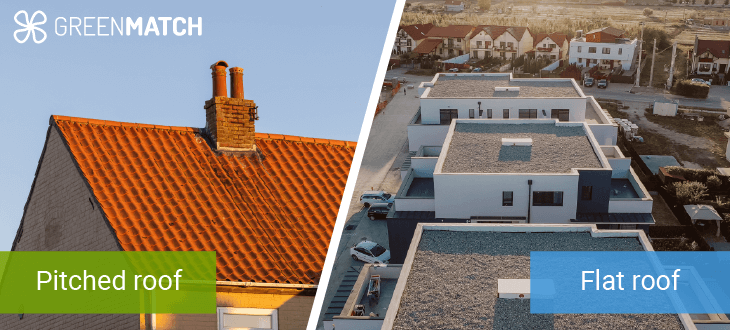
Pitched and flat roof insulation differ significantly in installation, and cost. Pitched roofs are typically known for their triangular shape. They are the most common type of roof in the UK, with over 92% of properties having them, according to GOV.UK. Insulating a pitched roof is generally more complex and expensive due to its shape.
It often involves placing insulation materials between the rafters or under the roof slope, which can be challenging and labour-intensive. Pitched roofs, despite their challenges, provide better insulation and promote higher energy efficiency. There are two main types of insulation for pitched roofs: cold and warm.
A flat roof is characterised by a horizontal or shallow slope, making insulating the roof simpler and more cost-effective than pitched roofs, as it requires less material and is less labour-intensive to install. While some homes in the UK have flat roofs, most flat roofs in the UK (81%) belong to high-rise buildings.
Flat roofs in the UK are considered challenging to insulate, as many were built with little to no prior insulation. Additionally, due to the lack of a slope, flat roofs can increase the risk of water pooling, damage installed insulation, and increase future repair costs. For flat roofs, there are three methods to consider when installing insulation: warm deck, cold deck, or inverted roof.
The type of roof insulation you need depends on the style and era of your home. Traditional Victorian and Edwardian homes and new builds from the 90s onwards typically feature pitched roofs.
On the other hand, many 1970s terrace houses, minimalist homes, and Art Deco properties were designed with flat roofs. We will explore primary insulation methods for pitched and flat roofs, highlighting the differences and benefits of each approach.
Flat roof insulation
Flat roof insulation is essential for maintaining energy efficiency and protecting the structural integrity of properties with flat roofs. This type of insulation involves installing insulating materials either above or below the roof deck, or incorporating a combination of both in some cases. There are three types of insulation you can choose for your flat roof:
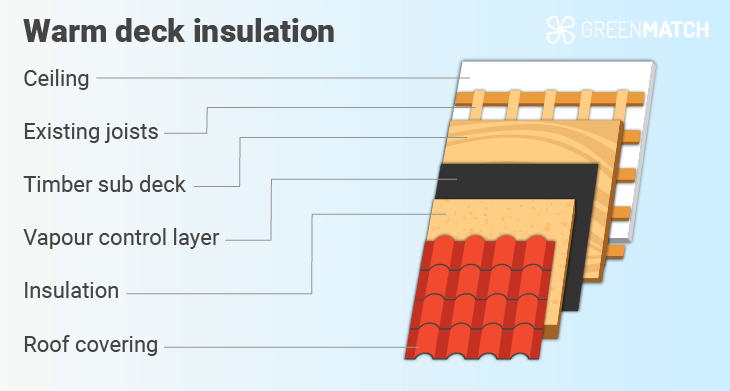
- Warm deck insulation involves placing the insulation above the structural deck and under the water proofing layer. This creates a continuous thermal barrier, preventing heat loss and reducing condensation within the roof structure. The insulation and structural support are protected from weather conditions, making it particularly beneficial for damp UK locations.
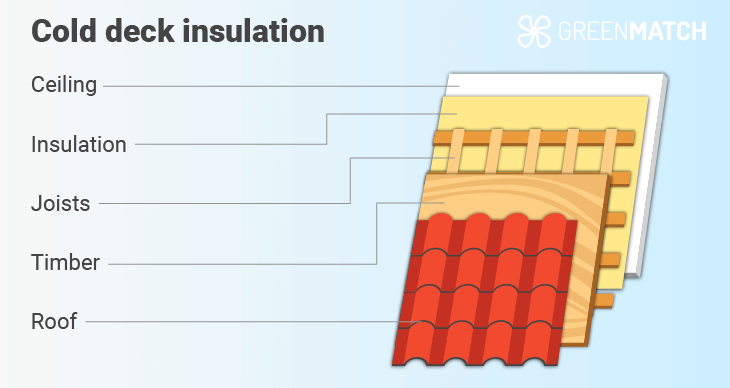
- Cold deck insulation involves placing the insulation below the structural deck and waterproofing layer and leaving a ventilated cavity between the deck and the insulation. This method is considerably cheaper than a warm deck but less energy efficient. Leaving a cavity between the insulation and the waterproofing layer for ventilation is essential. Without proper ventilation, condensation can form within the roof as the cold deck stays exposed to external temperatures.
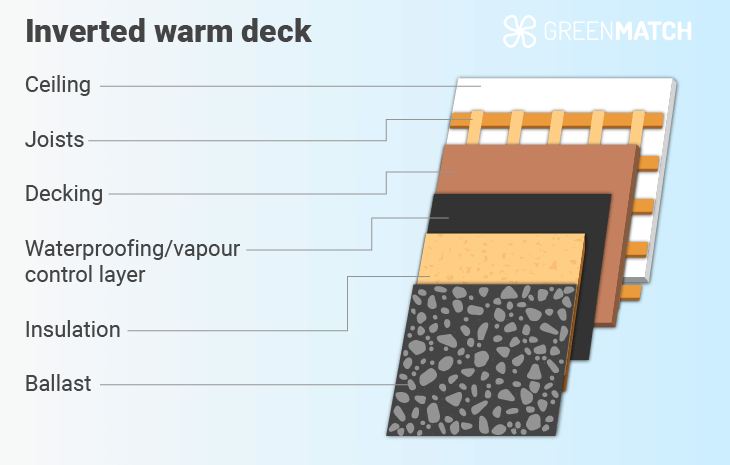
- Inverted roof insulation involves placing the insulation layer above the waterproofing layer and roofing deck. It is similar to a warm deck but installed upside down, hence the term "inverted roof". This type of insulation protrudes from the flat roof and typically features a covering of gravel or similar material. Additionally, inverted roof insulation is less energy-efficient. It is prone to condensation, so it is recommended to increase roof insulation thickness by 20%, according to Foamglas.
When selecting between warm, cold, and inverted roof insulation, the choice depends on your roof structure, climate, and insulation requirements. In most instances, warm deck insulation is the preferable option. However, cold decks and inverted roofs offer a more cost-effective alternative.
Pitched roof insulation
Pitched roof insulation effectively enhances the energy efficiency and comfort of homes with sloped roofs. This type of insulation typically involves placing insulation materials between the rafters, above the rafters, or at ceiling level.
- Cold insulation is a cost-effective way to insulate a sloped roof. Install insulation over and between the joists at ceiling level, leaving the attic space uninsulated and at a lower temperature. This method is suitable for storage loft spaces but not living spaces. Additionally, cold insulation can be placed between the joists of the attic. Although cost-effective, it's essential to ensure proper ventilation in the attic to avoid condensation and dampness issues.
- Warm insulation is installed directly under the roof in the plane of the roof's pitch, creating a thermal barrier that keeps the entire roof space warm. Ideal for those with converted lofts, it keeps attic spaces cool in summer and warm in winter. While more expensive than cold insulation, it doesn’t require ventilation, saving on labour and material costs.
When deciding between cold and warm insulation, consider the attic's intended use, climate, and budget. Warm insulation is best for colder climates like the UK, especially for converted loft spaces. On the other hand, cold insulation is a more practical and budget-friendly option.
Roof insulation types
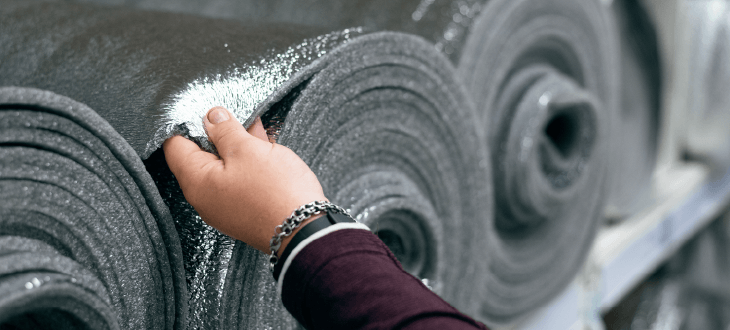
Roof insulation materials come in various forms, each with distinct properties and advantages tailored to different roofing structures and insulation needs. Below are the most common types of roof insulation materials available in the UK:
- Polyisocyanurate (PIR) boards
- Polystyrene (EPS) boards
- Polyurethane (XPS) boards
- Mineral wool
- Spray foam
- Fibreglass
- Cellulose
- Sheeps wool
Insulation materials must be chosen with specific pitched or flat roof considerations to ensure optimal performance and longevity. Insulation for pitched roofs should fit nicely between rafters and provide effective thermal barriers.
For flat roofs, materials should offer thermal efficiency and robust moisture resistance. This often involves using rigid foam boards or spray foam insulation.
Selecting the appropriate insulation type tailored to the roof design ensures energy efficiency and structural protection. In the following sections, we will discuss the best materials for flat and pitched roofs and their pros and cons.
Insulation materials for flat roof insulation
Flat roof insulation requires materials that offer superior thermal performance, moisture resistance, and structural support. Below are the top materials for flat roof insulation.
Polyisocyanurate boards (PIR)
PIR boards are made from plastic foam and have a high R-value ranging from 5.6 to 7.0, depending on the product and temperature, signifying excellent resistance to heat flow. These boards are lightweight, easy to install, and suitable for warm and cold roof insulation.
PIR is compatible with most cladding and roofing materials, including metal, brick, stone, wood, vinyl, and asphalt shingles. It can be attached using adhesives such as mechanical fasteners. Additionally, it is fire-resistant and has a minimal environmental impact compared to other rigid board insulations.
However, it is essential to consider that PIR boards can cost around £12.50 per m2. Additionally, it has a low resistance to water absorption. According to the Green Insulation Group, PIR boards can absorb up to 3% of their weight in water when exposed to wet conditions.
This water absorption can reduce their R-value, potentially leading to mould growth and rot. Additionally, the R-value decreases in colder climates.
- High R-value
- Easy to install
- Compatible with most roofing material
- Fire-resistant
- Compatible for cold and warm roof insulation
- Susceptible to water absorption
- R-value decreases in colder climates
- Cost more than EPS Rigid Foam Boards
Expanded Polystyrene (EPS)
EPS is a thermoplastic foam with a consistent R-value of 4 to 4.5. Unlike PIR, its R-value is unaffected by cold or hot climates. However, it has the lowest R-value of the three types of rigid board insulation.
Manufacturers offer this material in various thicknesses and can cut it to fit your roof's dimensions. It is also the most cost-effective option among the three types of rigid board insulation, costing around £10 per m2. Use EPS only for warm decking insulation.
Despite its versatility in thickness, EPS is not compatible with certain types of cladding and roofing materials, such as asphalt shingles, hot mop, or torch-down roofs, as high temperatures and solvents can damage it. An additional protective coat or layer is necessary to prevent damage. EPS is also not as fire-resistant as PIR insulation and can melt and drip during extreme temperatures, potentially spreading fire and creating toxic fumes.
- Cost-effective
- Consistent R-value
- Easy to cut and install
- Various thickness available
- Low R-value compared to PIR or XPS
- Flammable
- Not suitable for cold decking insulation
- Not suitable to some cladding and roofing material
Extruded Polystyrene (XPS)
XPS is a thermoplastic foam that extrudes polystyrene with a blowing agent through a die. It has a high R-value, ranging from 5 to 6 depending on the product and temperature.
Its exceptional durability and high compressive strength make it ideal for flat roof insulation, as it can withstand high loads and impacts without cracking.
It absorbs less than 1% of water, maintaining its R-value and structural integrity, making it ideal for damper climates. XPS is also suitable for warm and cold decking insulation.
Despite its benefits, XPS is pricier than both PIR and EPS and can cost around £21.50 per m2. It is not as fire-resistant as PIR, making it unsuitable for cladding and roofing materials, such as asphalt shingles, hot mopping, or torch-down roofing. Similar to EPS, when exposed to high heat, it can melt and drip, spreading fire and toxic fumes.
- Durable and strong
- Moisture resistant
- High R-value
- Suitable for warm and cold decking insulation
- High cost
- Flammable
- Not suitable to some cladding and roofing materials
Mineral Wool
Mineral wool is a fibre-based insulation that resembles wool in appearance. There are two types of mineral wool available: rock and glass mineral wool.
Manufacturers produce glass mineral wool from recycled glass or sand, while rock wool (or stone wool) is processed from volcanic rock like dolomite or basalt.
Rock wool (or stone wool) is a durable insulation material that can come in the form of rolls, batts, and boards and is suitable for all types of flat roofs.
However, mineral wool is denser than other materials, making the installation more challenging. It is also more durable and more accessible to cut.
Wear protective gear when installing this material to prevent stone or glass fibers from lodging in the skin. These fibres are small enough to be inhaled, potentially affecting the lungs and causing lung disease.
On average, mineral wool has an R-value of between 3.7 and 4.3 per inch, which is lower than that of PIR and XPS insulation. Mineral wool resists fire more effectively than fibreglass, EPS, XPS, and PIR boards, enhancing home fire safety. It is also naturally moisture resistant, meaning it won't absorb water and prevents mould growth and mildew.
Mineral wool's fibrous nature also makes it one of the most effective materials for sound absorption. It converts sound waves into heat energy, whereas other materials allow them to pass through.
Mineral wool is one of the most expensive materials due to its many benefits, with an average cost of around £15.25 for glass wool and £18.20 for rock wool.
- Fire-resistant
- Water resistant
- Sound absorption
- Suitable for warm and cold decking
- High cost
- Heavy weight
- Damages skin without protective gear
- Damages lungs without protective gear
- Low R-value compared to PIR and XPS
Spray Foam
Spray foam insulation combines polyol resin and some form of isocyanate. It is available in two forms: open and closed. Open-cell spray foam is lightweight, while closed-cell is denser.
When applied as a liquid, spray foam fills the entire cavity, providing an airtight seal. In contrast, standard insulation can leave gaps, leading to potential heat loss of up to 50%, according to CheckaTrade.
Open-cell spray foam has an R-value of 3.6 to 3.9 per inch, whereas closed-cell spray foam has an R-value of 6 to 7. Both types are suitable for warm and cold deck insulations.
Due to the materials used in creating spray foam, it cannot grow mould or mildew, even if it becomes damp. Moreover, spray foam is known for its longevity and could last up to 100 years if properly installed.
As open-cell spray expands further than closed-cell foam, less material is used, making it more cost-effective. The cost of open-cell is £55 per m2, whereas closed-cell is £70 per m2. Spray foam insulation is not DIY-friendly due to its complex installation process and requires professional installation.
Spray foam chemicals can release harmful chemicals, which can have adverse health effects if not correctly handled. Your home must be vacated for 24 hours while it is curing. Another drawback of spray foam is that it is flammable, making it prone to spreading fire and releasing toxic chemicals.
- Closed cell has high R-value
- Airtight
- Suitable for warm and cold deck insulation
- Longevity
- Moisture resistant
- Flammable
- High-cost
- Health risks
- DIY not possible
Insulation materials for pitched roof insulation
When choosing pitched roof insulation, consider thermal performance, fire resistance, moisture resistance, and ease of installation. Some materials suitable for flat roof insulation, such as mineral wool, rigid foam boards (PIR, EPS, XPS), and spray foam, also work for pitched roofs.
In addition to these, other materials are specifically compatible with pitched roof insulation. We will discuss these materials in more detail below.
Fibreglass
Fibreglass is popular because it is the cheapest insulation material available, costing an average of £10 per m2. Made of glass, this insulation comes in blankets, also known as batts, and is available as loose fill. You can place it between rafters, joists, blocks, studs, and any surface needing insulation, making it flexible and easy to install.
When installing fibreglass, you must wear protective gear to avoid skin irritation and inhalation of fibres, which can cause respiratory issues.
In both forms, fibreglass has an R-value of 3 to 4 per inch. Fibreglass cannot absorb water; however, it can hold onto water and moisture in its structure, decreasing its ability to block heat transfer and its R-value. As a result, mould and mildew can grow.
Fibreglass is fire-resistant and can withstand temperatures up to 540 degrees Celsius, so it will not spread fire within your home. It is also an excellent soundproofing material.
- Cost-effective
- Easy to install
- Fire-resistant
- Sound absorption
- Health risks
- Moisture sensitivity
- Mould and mildew can grow
Cellulose
Manufacturers create cellulose insulation by recycling paper into loose-fill material, usually available in wet or dry form. It is ideal for pitched roofs and offers easy installation, although it requires specialised equipment, making DIY installation more challenging.
Cellulose is among the most eco-friendly materials for roof insulation, making it perfect for those looking to reduce their carbon footprint. It is also a cost-effective option, averaging £11 per m2.
In addition to its cost-effectiveness, cellulose insulation has an R-value between 3.1 to 3.8 per inch. It is naturally resistant to fire as it is treated with boric acids, making it resistant to mould.
However, it is susceptible to moisture absorption, which can cause sagging and settling over time, reducing its R-value and thus requiring a vapour barrier.
Another drawback is that cellulose insulation creates dust during installation, necessitating a protective mask. Nonetheless, it poses fewer health risks than fibreglass.
- Eco-friendly
- Cost-effective
- Fire-resistant
- Easy to install
- Moisture sensitivity
- Susceptible to sagging and settling
- DIY is difficult
- Dust generated during installation
Sheep wool
Sheep wool fibres are either mechanically held together or bonded to form insulating batts and rolls. This natural and sustainable material has become increasingly popular due to these attributes.
Sheep wool insulation fits well for pitched roofs due to its excellent thermal and acoustic properties. It installs easily between or over the rafters, providing a continuous insulation barrier.
On average, sheep wool will cost around £19.75 per m2, which is more expensive than cellulose, another sustainable insulation material. It has an R-value of 3.5 to 3.8 per inch and can absorb 30% of water before its R-value is affected.
Wool can absorb and release moisture without compromising its insulating properties, making it particularly effective in preventing condensation and mould growth. However it is susceptible to pests as it is an organic material.
Additionally, it is fire-resistant as the material only chars when there is insufficient oxygen in the air to support the combustion of wool. It will not fuel the fire in a blaze and produce no toxic gases.
It is easy to install and requires no protective gear, as it will not irritate the skin and respiratory systems. Its flexibility allows it to fit snugly into various spaces, making it suitable for pitched roofs where it can easily accommodate the angles and contours of the roof structure.
While less commonly used in flat roofs due to moisture concerns, it can still be a practical option with proper protective measures.
- Moisture regulation
- Eco-friendly
- Fire-resistant
- Easy to install
- Suitable for pitched and flat roof
- Expensive
- Lowe R-value compared to other materials
- Susceptible to pests
Roof insulation grants
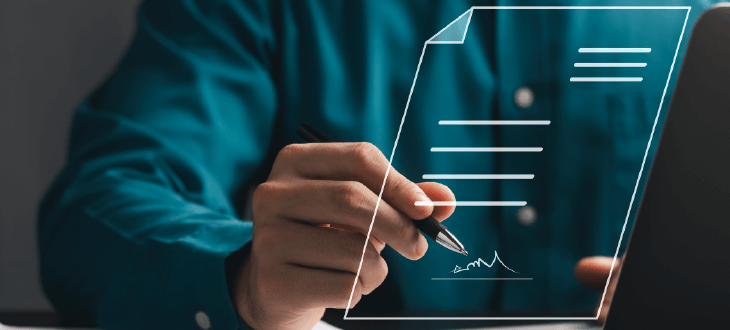
In the UK, several insulation grants and funding programs are available to help homeowners improve their roof insulation, enhancing energy efficiency and reducing heating costs. Below are a list of available grants in the UK for roof insulation:
- Great British Insulation Scheme: This grant is one of the primary grants available in England, Wales, and Scotland. This program allows homeowners, landlords, and tenants to receive free or low-cost insulation to reduce energy bills effectively. However, tenants are required to communicate with their landlord beforehand. If your home has an EPC rating of D, which can be lowered to G, or your home falls within Council bands A-D in England and A-E in Scotland or Wales, you may be eligible for this grant.
- Energy Obligation Grant: The ECO scheme requires medium and large energy suppliers to fulfil a Home Heating Cost Reduction Obligation (HHCRO). These suppliers are then obligated to assist low-income, fuel poor and vulnerable households to heat their homes. This includes installing insulation to those households to reduce the energy bills.
- Warmer Homes Scotland scheme: In Scotland, this grant scheme covers all costs for energy improvements like attic insulation, wall insulation, draught proofing, and central heating for eligible households. It's aimed at families meeting specific criteria, such as having a member over 75 with no central heating, being terminally ill, or receiving certain benefits. Additionally, eligibility extends to homes in Council Tax bands A-F, those with a floor area of 230m² or less, or those with a poor Energy Performance Certificate (EPC).
- Affordable Warmth Scheme: This grant scheme is designed for Northern Ireland to help low-income individuals in private accommodations with energy efficiency improvement costs. Eligible applicants include private homeowners or those renting from private sector landlords, with an income of £23,000 or less.
To explore current grants and determine your eligibility, contact your local authority and visit your government's website to learn more about the requirements of each grant.
Building regulations for roof insulation thickness
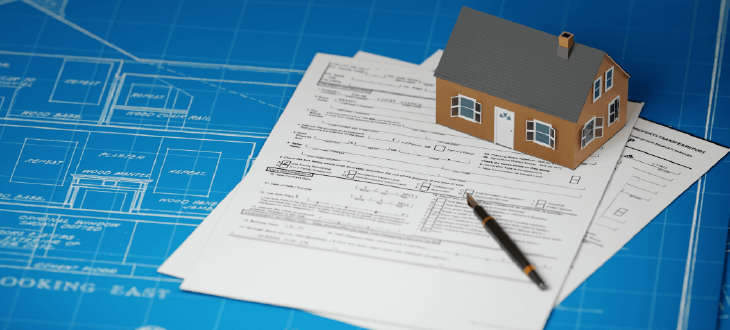
In the UK, roof building regulations specify minimum insulation thicknesses to ensure energy efficiency and reduce carbon emissions. The regulations require that roof insulation have a specific U-value expressed in W/m²K for new builds and home renovations.
A U-value, known as thermal transmittance, measures how well a building component, such as roof insulation, conducts heat. For pitched and flat roof insulation, the required U-value is 0.16 W/m²K, and to achieve this, the cold and warm loft insulation thickness should be at least 270mm.
Consult an expert to determine your roof insulation's R-value and your roof's current U-value. You may need additional layers if the material's R-value is low, increasing overall thickness.
If your home already has insulation, you only need to add enough to meet the required U-value. This means you will spend less on insulation than a home without insulation. If insulation thickness affects roof headspace, discuss potential adjustments with experts and your local authority.
You don't need building permission for roof insulation if no structural changes are made to the height or shape. However, compliance with standards is crucial, and consulting a professional ensures your insulation meets current regulations. Failing to comply with building regulations could halt your renovations or a potential fine from your local authority.
Best roof insulation material
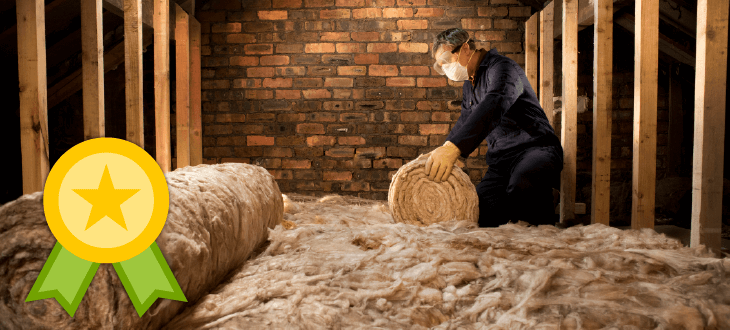
Choosing the best roof insulation material depends on various factors, including the type of roof, budget, effectiveness, and sustainability.
Fibreglass batts and rolls are popular for pitched roofs due to their affordability, ease of installation, and good thermal performance. At an average cost of £10 per m2, this is the best choice for those looking for a budget-friendly option to insulate their roof.
For flat roofs, rigid foam boards such as polyisocyanurate (PIR) are cost-effective, costing an average of £12.50 per m2. While not as cheap as expanded polystyrene (EPS), PIR provides many benefits, such as being flame-resistant, suitable for almost all cladding and roofing materials, and having a much higher R-value.
Rigid foam boards can also be used for pitched roofs. If you want the best insulation for your roof with the highest thermal efficiency, PIR or extruded polystyrene (XPS) boasts the highest R-values. PIR has an R-value of 5.6 to 7.0 per inch, whereas XPS has an R-value of 5 to 6 per inch. Rigid foam boards are generally the easiest and most efficient way to insulate a roof, especially for warm deck insulation.
For those prioritising sustainability, sheep wool insulation is an eco-friendly option. It is made from a renewable resource and is biodegradable, although it can be more expensive, costing around £19.75 per m2.
For those prioritising sustainability and cost-effectiveness, cellulose is the next best option. At an average cost of £11 per m2, this material is made from recycled cardboard and newspapers, allowing you to reduce your carbon footprint while being budget-conscious.
The best insulation material should match your roof type, budget, thermal and acoustic performance, and sustainability goals. Consulting with a professional can provide tailored advice to ensure optimal insulation performance.
How to insulate a roof
Proper roof insulation is essential for energy efficiency, comfort, and protection from the elements. On average, insulating a standard UK 3-bedroom semi-detached home costs around £930. To save on labour costs, it is possible to do the roof insulation yourself. Below are the steps in how to insulate a roof:

1. Choose the right Insulation material
Consider materials like fibreglass batts, mineral wool, rigid foam boards, and spray foam. Choose based on factors like thermal resistance, moisture resistance, and ease of installation, considering your roof type and climate.

2. Prepare the roof space
Check for existing damage or leaks and clear away debris, old insulation, or obstructions. Ensure proper ventilation in the roof space to prevent moisture buildup and condensation.

3. Measure and cut Insulation
Accurately measure the spaces between rafters or joists and trim the insulation material to fit snugly. Wear protective clothing, gloves, and a mask to avoid irritation from insulation fibres.
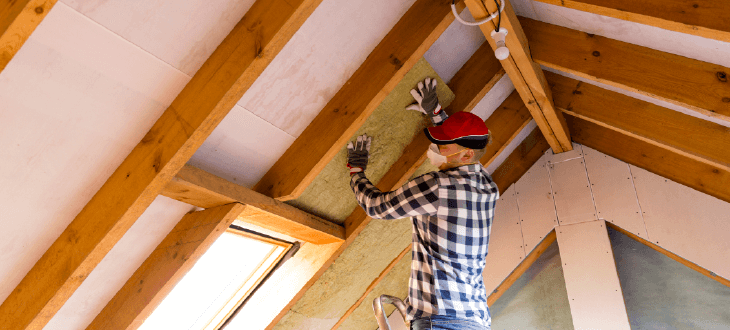
4. Install the insulation
- For cold roof insulation between rafters fit the insulation tightly between the roof rafters, and consider adding a second layer perpendicular to the first for extra thermal resistance.
- For warm roof insulation above rafters, lay insulation boards over them to cover them completely.
- Inverted warm deck external roof insulation (primarily for flat roofs) place insulation boards directly on top of the waterproofing membrane, staggering the joints to avoid thermal bridging.
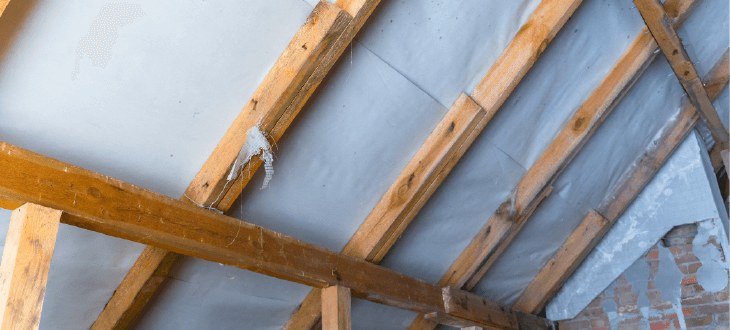
5. Add a vapour barrier (if needed)
Place a vapour barrier on the warm side of the insulation to prevent moisture from penetrating and causing mould or dampness. For inverted warm deck insulation, you must lay boards on top of the waterproof barrier.
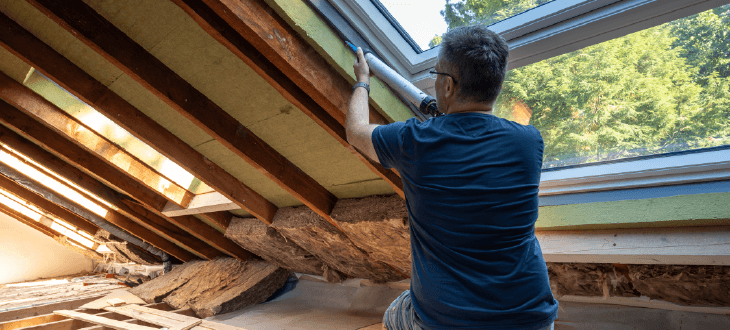
6. Seal gaps and finish
Use sealant or foam to fill gaps around pipes, vents, or other penetrations. Then, cover the insulated area with drywall or another suitable material for the interior. Cover the boards with a ballast material like gravel, pavers, or green roof components for flat roof inverted warm deck insulation, depending on the roof’s intended use.
7. Inspect and maintain
Regularly inspect the insulation for damage, moisture, or pests, and promptly address any issues to keep the insulation effective.
Proper roof insulation is crucial for energy efficiency, comfort, and protection. If your loft is easy to access, free from damp issues, and is not a flat roof, you can insulate it yourself. For damp or flat roofs, we advise seeking professional assistance to avoid costly damage.
At Greenmatch, we recommend working alongside at least one professional to guide you during your DIY roof insulation. This ensures you meet building regulations and install the insulation materials correctly to achieve maximum energy efficiency.
Is insulation for a roof an option for you?
Insulating your roof is an excellent investment for several reasons. Firstly, it significantly improves energy efficiency by reducing heat loss in winter and keeping your home cooler in summer, which can lead to substantial savings on heating and cooling bills.
On average, you can save between £270 and £445 on your annual energy bills based on your property type. With these savings, it will only take around 3 to 4 years to pay off the initial cost of your roof insulation.
Moreover, roof insulation improves indoor comfort by maintaining a consistent temperature throughout the home, eliminating cold drafts, and reducing the need for continuous heating or cooling adjustments. It can also improve the air quality of your home by reducing dampness and mould and preventing respiratory infections and asthma.
From an environmental perspective, insulating your roof helps reduce your carbon footprint by lowering energy consumption, contributing to the fight against climate change. Roof insulation can cut your carbon emissions by 0.6 to 1 ton annually. Insulation materials like sheep wool and cellulose are sustainable options that minimise environmental impact.
Additionally, well-insulated roofs can increase property value. Homes with energy-efficient features, including roof insulation, are more attractive to buyers and can command higher prices in the real estate market. Energy improvement renovations can increase your property’s value by 14%.
Lastly, insulation can help with soundproofing, reducing noise from outside and creating a quieter, more serene indoor environment. This mainly benefits homes in noisy urban areas or near busy roads.
Insulating your roof is a wise investment considering the benefits of energy savings, increased comfort, environmental impact, property value enhancement, and noise reduction. Greenmatch can help by providing four free, non-binding quotes from local insulation installers tailored to your budget and needs. Just fill out our quick 30-second form to receive these quotes without any obligation or hidden costs.
- Describe your needs
- Get free quotes
- Choose the best offer
It only takes 30 seconds



FAQ
The best roof insulation depends on factors like roof type, budget, and thermal needs. Fibreglass batts and rolls are affordable and easy to install for pitched roofs. Meanwhile, rigid foam boards like polyisocyanurate (PIR) or extruded polystyrene (XPS) offer superior thermal efficiency and moisture resistance for both pitched and flat roofs.
Yes, you should insulate between roof rafters if you are creating a warm roof where the insulation is placed directly under the roof surface.
The cost to insulate a roof in the UK for a standard 3-bedroom semi-detached home is around £930. Prices can depend on factors such as roof type, insulation material, and property size.
You can insulate your roof if it’s easily accessible, free from damp issues, and not a flat roof. However, for more complex insulation needs, damp problems, or flat roofs, hiring a professional is recommended to ensure proper installation and effectiveness.
The most efficient way to insulate a roof is to use rigid foam boards like polyisocyanurate (PIR) or extruded polystyrene (XPS) especially if you are opting for warm roof setup as they are easy to install between the rafters.

Caoimhe is an experienced content writer and researcher who is passionate about providing accessible information to every reader. With a background in English literature and Sociology, she combines the two disciplines to create cohesive, well-thought-out, and well-informed pieces.
We strive to connect our customers with the right product and supplier. Would you like to be part of GreenMatch?

- Roof Insulation: A complete Guide (2025)
- Benefits of roof insulation
- Roof insulation cost in the UK
- Pitched or flat roof insulation
- Roof insulation types
- Roof insulation grants
- Building regulations for roof insulation thickness
- Best roof insulation material
- How to insulate a roof
- Is insulation for a roof an option for you
- FAQ




